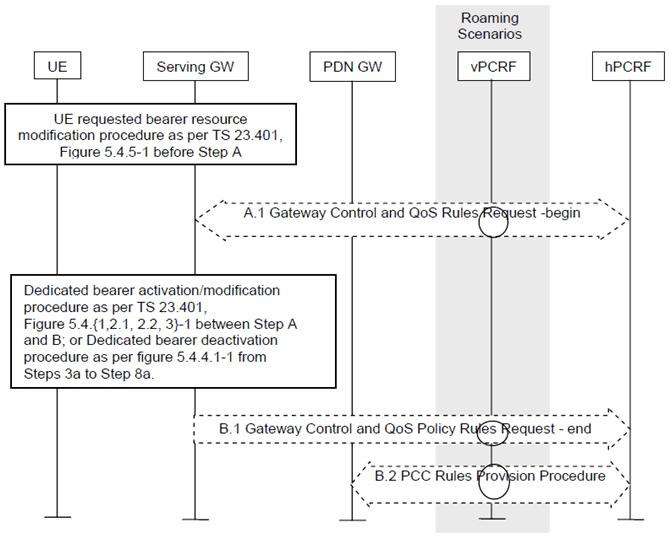Content for TS 23.402 Word version: 18.3.0
0…
4…
4.2…
4.2.2
4.2.3
4.3…
4.4…
4.5…
4.5.7…
4.6…
4.7…
4.7.2…
4.8…
4.8.2a…
4.9…
5…
5.2…
5.4…
5.5
5.6…
5.7…
5.8…
6…
6.2…
6.3
6.4…
6.4.3…
6.5…
6.6…
6.7…
6.8…
6.10…
6.13…
6.15…
7…
7.2…
7.3
7.4…
7.5…
7.6…
7.8…
7.10…
8…
8.2.1.2
8.2.1.3…
8.2.2
8.2.3…
8.2.6…
8.3…
8.4…
8.5…
9…
9.3…
9.4…
10…
13…
16…
16.1.2…
16.1.6…
16.2…
16.2.1a…
16.3…
16.4…
16.7…
16.8…
16.10…
17…
A…
C…
E…
5.5 UE-initiated Resource Request and Release p. 97
This clause is related to the case when UE-initiated resource request and release is supported, and it is utilized for the PMIP-based S5/S8 traffic flow aggregates.
In the non-roaming case, vPCRF will not be involved.

Figure 5.5-1: UE-initiated resource request/release with PMIP-based S5/S8
(⇒ copy of original 3GPP image)
(⇒ copy of original 3GPP image)
This procedure applies to the Non-Roaming (Figure 4.2.1-1), Roaming (Figure 4.2.1-2) and Local Breakout (Figure 4.2.3-4) cases. For the Roaming and Local Breakout cases, the vPCRF forwards messages between the Serving-GW and the hPCRF. In the Local Breakout case, the vPCRF forwards messages between the PDN-GW and the hPCRF.
The optional interaction steps between the gateways and the PCRF in the procedures in Figure 5.5-1 only occur if dynamic policy provisioning is deployed. Otherwise policy may be statically configured with the gateway.
Step A.1.
Steps between A.1 and B.1 are described in clauses 5.4.1, 5.4.2 and 5.4.3 of TS 23.401 for resource allocation/modification or clause 5.4.4.1 for resource deactivation. Based on the QoS policy rules, the Serving-GW decides whether to initiate a dedicated resource allocation activation or dedicated resource allocation modification (with or without QoS update).The Serving-GW uses this QoS policy to assign the EPS Bearer QoS, i.e. it assigns the values to the bearer level QoS parameters (excluding AMBR); see clause 4.7.3 of TS 23.401 and sends the appropriate message to the MME.
The Serving-GW initiates the Gateway Control and QoS Policy Rules Request Procedure as specified in TS 23.203. The Serving-GW provides the content of the Traffic Aggregate Description (TAD) and the requested QoS change to the PCRF as an Event Report. The PCRF makes a PCC decision as a result of the Gateway Control and QoS policy request and provides the updated QoS Rules to the Serving-GW. The PCRF declaration of support for the extended TFT filter format is a precondition for the Serving-GW accepting and forwarding TAD filters that use the extended TFT filter format to the PCRF.
Step B.1.
The Serving-GW indicates to the PCRF whether the requested QoS Policy Rules Provision could be enforced or not and indicates User Location Information and/or UE Time Zone Information to the PCRF as an Event Report if the corresponding event trigger is set. This completes the GW Control and QoS Rules Provision procedure started in step A.1.
Step B.2.
The PCRF initiates the Policy and Charging Rules Provision Procedure as specified in TS 23.203 to update the PCC rules in the PDN-GW.